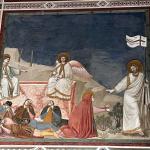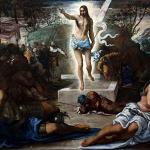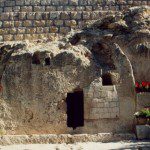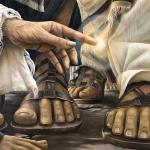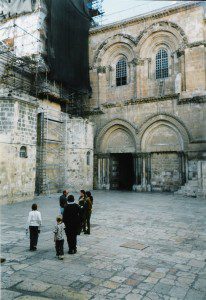 I’ve been slowly working through The God of Hope and the End of the World by John Polkinghorne and Surprised by Scripture by N. T. Wright. The books converged this week as I read Polkinghorne’s chapter on The Resurrection of Jesus and Wright’s chapter Can a Scientist Believe in the Resurrection?. It is a little early, I suppose, but quite timely as we approach Easter in just a few weeks. Obviously Polkinghorne’s answer to Wright’s question is yes, as is Wright’s answer. Wright would also say it is the wrong question and Polkinghorne would agree. The resurrection isn’t a scientific question. It is a historical question and a faith question. The picture, by the way, was taken when we visited the Church of the Holy Sepulchre in Jerusalem in 2001.
I’ve been slowly working through The God of Hope and the End of the World by John Polkinghorne and Surprised by Scripture by N. T. Wright. The books converged this week as I read Polkinghorne’s chapter on The Resurrection of Jesus and Wright’s chapter Can a Scientist Believe in the Resurrection?. It is a little early, I suppose, but quite timely as we approach Easter in just a few weeks. Obviously Polkinghorne’s answer to Wright’s question is yes, as is Wright’s answer. Wright would also say it is the wrong question and Polkinghorne would agree. The resurrection isn’t a scientific question. It is a historical question and a faith question. The picture, by the way, was taken when we visited the Church of the Holy Sepulchre in Jerusalem in 2001.
The Riddle of Jesus. Jesus lived some 2000 years ago, a relatively short life, before he was put to death by the local authorities. This is a rather unremarkable story. Many charismatic leaders over the years have been put to death by authorities. “Yet,” as Polkinghorne says, “we have all heard of Jesus, and that in itself is a significant fact about him. The riddle of Jesus is why someone whose life seemed to end in complete failure has proved to be the most influential figure in the history of the world.” (p. 67) He goes on:
Within just a few weeks of his miserable death, … [his followers are] … proclaiming that this Jesus, this rejected and crucified man, has been made by God ‘both Lord and Messiah’ (Acts 2:36). That is to say, they believe that uniquely in him God’s will and salvific purpose are being fulfilled. Our task is to understand how this tremendous change came about. Such a remarkable transformation requires a commensurately remarkable cause. The first disciples claimed that it was because ‘God raised him up, having freed him from death, because it was impossible for him to be held by its power’ (Acts 2:24). Who Jesus was, and what his real significance was, turns on whether this claim is true. The resurrection is pivotal for Christian belief. (p. 67)
1 Cor. 15 is a crucial passage here. Both Polkinghorne and Wright refer to it.
For I handed on to you as of first importance what I in turn had received: that Christ died for our sins in accordance with the scriptures, and that he was buried, and that he was raised on the third day in accordance with the scriptures, and that he appeared to Cephas, then to the twelve. Then he appeared to more than five hundred brothers and sisters at one time, most of whom are still alive, though some have died. Then he appeared to James, then to all the apostles. Last of all, as to one untimely born, he appeared also to me. (v. 3-8)
According to Polkinghorne when Paul refers to what he had received he would be thinking back to his earliest instruction in the faith. The use of the Aramaic Cephas and reference to ‘the twelve’ support a very early date for the composition of the summary statement repeated here (later) by Paul. And Paul was certainly convinced that the resurrection was true and central. A few lines later he writes: “If there is no resurrection of the dead, … we are even found to be misrepresenting God, because we testified of God that he raised Christ.” Paul, devout Jew, a Pharisee no less, would certainly rather die than be found to be misrepresenting God.
Seven “mutations” in resurrection. In Surprised By Scripture Wright emphasizes the surprising nature of the story of the resurrection and the direction Christianity took in response to their experience with resurrection. He looks at seven specific features of the faith – mutations from the concept of resurrection as it was understood in 1st century Judaism.
1. There is a unified Christian position on resurrection in the early church. Judaism had a spectrum of views, Christian belief had no significant spectrum on the general truth of resurrection. Now of course there were variations and discussions around details, but a view similar to the Sadducees, who denied resurrection altogether, is not in the mix.
2. More than this “in early Christianity, resurrection has moved from the circumference to the center.” Wright goes on:
You can’t imagine Paul’s thought without it. You shouldn’t imagine John’s thought without it, although some have tried. Take away the stories of Jesus’s birth, and all you lose is four chapters of the Gospels. Take away the resurrection and you lose the entire New Testament, and most of the second-century fathers as well. (p. 47)
3. The early Christians believed in a bodily resurrection. And not some vague understanding of body either. The spiritual body is a body animated by the Spirit – but still a physical body. Polkinghorne describes the spiritual body, still a physical body, “as a being totally suffused by the life-giving spirit of God.” (p. 77-78).
4. The view of resurrection has been split in two – already in Jesus, not yet for the rest of us.
5. The early Christians believed in a collaboration. They certainly believed that the resurrection had begun with Jesus and would be completed in the last day. “They believed also that God had called them to work with him, in the power of the Spirit, to implement the achievement of Jesus and thereby anticipate the final resurrection.” (p. 49)
6. They used resurrection as a metaphor in relation to baptism and holiness. You can’t get away from this in Romans 6 and it is also seen in Colossians.
7. Resurrection became associated with messiahship. “Nobody in Judaism had expected the Messiah to die, and therefore naturally nobody had imagined the Messiah rising from the dead.” (p. 49) Messianic belief among early Christians was reshaped by the resurrection.
The Gospel Accounts. Both Polkinghorne and Wright also point to the surprising nature of the Gospel stories as pointers to the fundamental truth and importance of the resurrection. The empty tomb, the women as first witnesses, and the resurrection appearances all point to the significance and early acceptance of the resurrection as foundational and true.
Wright suggests that the diversity and lack of New Testament hope in the stories is consistent with “an extremely early oral tradition that had been formed and set firmly in the memory of different story tellers before there was time for biblical reflection.” (p. 53) Biblical reflection permeates the rest of the Gospels, but the resurrection accounts were not something to be tampered with.
Polkinghorne points out that the stories about the resurrection appearances are definite, but not concrete. There is an element of mystery that the writers can’t quite pin down in both Luke and John. When Matthew notes that the disciples fell at his feet to worship, we are also told that some doubted. (Mt 28:17) “Such a non-triumphalist indication of the problematic character of recognizing the risen Christ, so variously expressed, seems to me much more likely to be the kernel of an historical reminiscence than a feature curiously common to a bunch of made up tales.” (p. 71)
Resurrection and Faith. Science can neither prove nor disprove the reality of the resurrection of Jesus, and can’t speak to the possibility of a future resurrection into something completely different.
The historical evidence points to something real that happened. But it can’t, of course, prove that this ‘something’ was in fact the resurrection. Nor can it prove that it wasn’t.
Ultimately the resurrection has to be accepted on faith, or rejected on faith. As Christians we accept the resurrection and the hope that it foreshadows as the story of God’s work in the world and plan for the future. In the Eucharist or communion bread and cup we proclaim the real presence of Christ and our hope for the future.
The confession of the Christian Church down the centuries has always been ‘Jesus lives!’ It’s discourse of Christ has not been in terms of a respectful recollection of a founder figure, but in the joyful acknowledgment of the living Lordship of Christ in the present. (p. 79 The God of Hope and the End of the World)
According to Wright it takes love to believe in the resurrection, whole person engagement and involvement with the mission of God.
All knowing is a gift from God, historical and scientific knowing no less than that of faith, hope and love; but the greatest of these is love. (p. 63 Surprised by Scripture)
The resurrection is absolutely central to Christian faith. Without it we have just another fully human charismatic founder, and a human philosophy and a human institution. The riddle of Jesus is answered in his death and resurrection through which he became both Messiah and Lord. This is worth meditating on as we move through the season, and indeed afterwards as well.
He is Risen Indeed.
If you wish to contact me, you may do so at rjs4mail[at]att.net.
If interested you can subscribe to a full text feed of my posts at Musings on Science and Theology.










